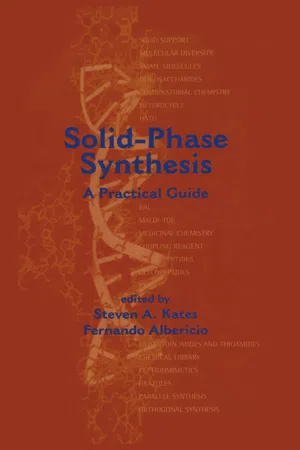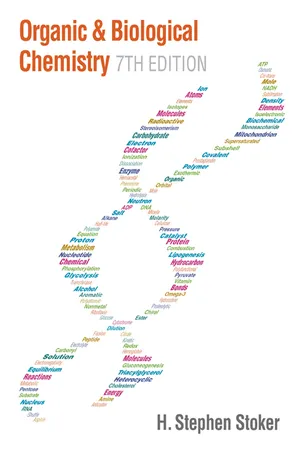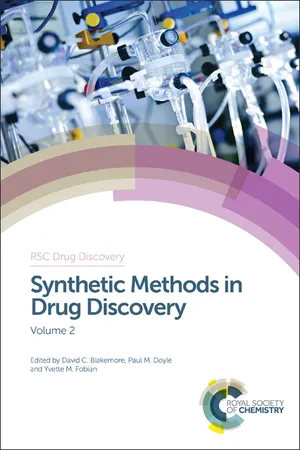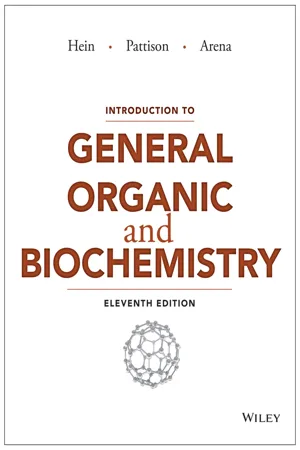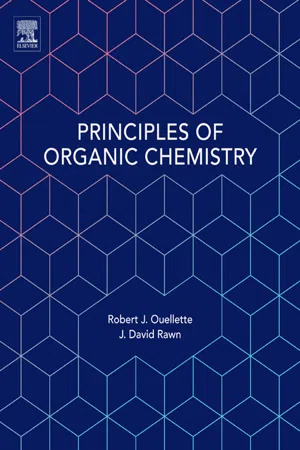Chemistry
Amide Formation
Amide formation is a chemical reaction in which an amide is produced by the condensation of a carboxylic acid derivative with ammonia or an amine. This reaction typically involves the nucleophilic attack of the carbonyl carbon of the carboxylic acid derivative by the nitrogen of the amine, followed by elimination of a leaving group. Amide formation is an important process in organic synthesis for the preparation of amide compounds.
Written by Perlego with AI-assistance
Related key terms
1 of 5
6 Key excerpts on "Amide Formation"
- eBook - ePub
Sustainable Catalysis
Challenges and Practices for the Pharmaceutical and Fine Chemical Industries
- Peter J. Dunn, K. K. (Mimi) Hii, Michael J. Krische, Michael T. Williams, Peter J. Dunn, K. K. (Mimi) Hii, Michael J. Krische, Michael T. Williams(Authors)
- 2013(Publication Date)
- Wiley(Publisher)
5 Direct Amide Formation Avoiding Poor Atom Economy Reagents Benjamin M. Monks and Andrew WhitingDepartment of Chemistry, Durham University, Durham, UK5.1 Introduction
The carboxylic acid amide is not only a common functionality in organic compounds, it is also ubiquitous in the natural chemical and biochemical world. Indeed, analysis of the Comprehensive Medicinal Chemistry database reveals that the amide motif arises in around 25% of all synthetic pharmaceuticals [1], and as a result, amides are produced on a wide range of scales from milligrams to tonnes. The processes by which amides are made are therefore important, allowing both the rapid and high yielding synthesis of amides and providing routes that are amenable to scale-up and optimization.In 2005, the American Chemical Society, Green Chemistry Institute, Pharmaceutical Roundtable, which consisted of several prominent pharmaceutical companies, was formed in order to encourage and implement green chemical principles into the global pharmaceutical and chemical industry [2]. The Roundtable highlighted the Amide Formation reaction as a key process that invariably involved poor atom economy reagents. It was, therefore, highlighted as a key challenge to synthetic chemists to develop greener direct Amide Formation reactions, starting from carboxylic acids and amines, without the use of stoichiometric and high molecular weight reagents. In this review, recent developments that address these issues are surveyed.The most attractive method of accessing amides without attendant waste would be to directly react a carboxylic acid 1 and an amine 2 , and simply eliminate water via a seemingly straightforward condensation. Such a reaction would clearly be environmentally benign and would eliminate all waste. However, we are generally led to believe that this process is “seldom of preparative value” according to one leading advanced organic chemistry textbook [3]. In fact, the formation of an amide bond is thermodynamically favorable and is, therefore, expected to be facile. The main problems with the condensation reaction between a carboxylic acid and an amine are: (1) that it is impeded by a high energy of activation barrier [4, 5], which results in a reaction that is not widely understood from a mechanistic point of view [6, 7] and is certainly underdeveloped; and (2) since the pK a of most carboxylic acids is lower than that of many protonated amines, an ammonium carboxylate salt 3 forms preferentially, which is more resistant to the desired dehydration reaction [6, 7]. Indeed, the ammonium carboxylate salt to amide conversion requires temperatures in excess of 160 °C in order to force the direct thermal reaction [4, 6]. In consequence, there are no general methods for producing amides 4 directly at ambient temperatures, without resorting to the use of coupling or activating agents (Scheme 5-1 - eBook - PDF
Solid-Phase Synthesis
A Practical Guide
- Fernando Albericio(Author)
- 2000(Publication Date)
- CRC Press(Publisher)
6 Coupling Methods: Solid-Phase Formation of Amide and Ester Bonds Fernando Albericio University of Barcelona, Barcelona, Spain Steven A. Kates Consensus Pharmaceuticals, Inc., Medford, Massachusetts I. INTRODUCTION The formation of amides (Fig. I) is a key step in the construction (synthesis) of natural organic compounds as well as in de novo design [1]. The amide bond is present in peptides (peptide bond), peptoids, oligocarbamates, oli-goamides, and f3-lactams as well as many compounds containing rigid scaf-folds such as diketopiperazines, benzodiazepines, and hydantoins. Further-more, compounds containing amide bonds are excellent precursors for the preparation of heterocyclic compounds [2] (see Chapter 15). Thus, amide bonds play an important role in the synthesis of a majority of the compounds of biological interest. The controlled formation of the amide bond requires activation of the carboxylic group prior to reaction with the amino component. Another im-portant feature present in many organic compounds is an ester bond, which is typically constructed via activation of a carboxylic acid followed by re-action with an alcohol function. In this chapter coupling methods primarily based on the activation of a carboxylic acid leading to the formation of amides or esters on a solid phase are discussed. Other methods based on the formation of esters via the displacement of halides or activated alcohol moi-275 276 Albericio and Kates Figure 1 Formation of amides and esters. eties by the carboxylic-carboxylate function are outside the scope of this chapter. Coupling techniques have evolved rapidly [3-5], primarily from the field of solid-phase peptide synthesis because of the need to prepare long sequences and/or incorporate noncoded hindered amino acids [6-9]. - eBook - PDF
- H. Stephen Stoker(Author)
- 2015(Publication Date)
- Cengage Learning EMEA(Publisher)
C B O O NH 3 OH and O CH 3 CH O A CH 3 Summary of Chemical Reactions Involving Amines and Amides CHEMISTRY AT A GLANCE REVERSIBLE AMINE SALT FORMATION Acidic Conditions Reaction of amine with a strong acid Protonation of amine occurs. Amine amine salt Reaction of amine salt with a strong base Deprotonation of amine salt occurs. Basic Conditions ALKYLATION OF AMINES Reaction with an alkyl halide Basic conditions (NaOH) required Ammonia 1˚ amine 1˚ amine 2˚ amine 2˚ amine 3˚ amine 3˚ amine quaternary ammonium salt Ammonia 1˚ amide 1˚ amine 2˚ amide 2˚ amine 3˚ amide Reaction with a carboxylic acid Temperature of 100˚C or greater Dehydrating agent AMIDIFICATION OF AMINES HYDROLYSIS OF AMIDES Acidic Hydrolysis Strong acid (HCl) Heating is often required. Amide acid + amine salt Strong base (NaOH) Basic Hydrolysis (Saponification) Amide acid salt + amine amine Amine salt Chemistry at a Glance—Summary of Chemical Reactions Involving Amines and Amides—summarizes the reactions that involve amines and amides. Copyright 2016 Cengage Learning. All Rights Reserved. May not be copied, scanned, or duplicated, in whole or in part. Due to electronic rights, some third party content may be suppressed from the eBook and/or eChapter(s). Editorial review has deemed that any suppressed content does not materially affect the overall learning experience. Cengage Learning reserves the right to remove additional content at any time if subsequent rights restrictions require it. 238 CHAPTER 6 Amines and Amides 6-19 Polyamides and Polyurethanes L E A R N I N G F O C U S Be familiar with the general structural characteristics of polyamide and polyurethane polymers; be familiar with common naturally occurring and synthetically produced polyamides and polyurethanes. Amide polymers—polyamides—are synthesized by combining diamines and dicar-boxylic acids in a condensation polymerization reaction (Section 5-18). - eBook - PDF
- David C Blakemore, Paul M Doyle, Yvette M Fobian(Authors)
- 2016(Publication Date)
- Royal Society of Chemistry(Publisher)
CHAPTER 17 Catalytic Amide Bond Forming Methods BENJAMIN N. ATKINSON, A. ROSIE CHHATWAL AND JONATHAN M. J. WILLIAMS* Department of Chemistry, University of Bath, Claverton Down, Bath BA2 7AY, UK *Email: [email protected] 17.1 Amidation of Carboxylic Acids The formation of amide bonds from carboxylic acids and amines is a widely investigated and documented process. 1,2 It is synthetically the most direct route to forming amide bonds with the sole by-product being water and is therefore of great interest. This transformation often requires the use of coupling agents to activate the carboxylic acid to nucleophilic attack. A wide range of coupling agents are typically employed in the pharmaceutical industry and the most commonly used and effective include CDI, HBTU, HATU, COMU, TBTU and T 3 P. While this method has its advantages within industrial processes, there have been significant developments generating more atom efficient, cheaper and cleaner methods of performing this reaction and this chapter will focus on these. While these methods are still developing, a key desire in industry is a highly effective catalytic amide coupling reaction and this chapter will examine the current state of the art. Several metal and non-metal catalysts have shown potential in catalysing this transformation. These catalysts aim to address some of the issues associated with the coupling agents that are currently used; however, their use does lead to some alternative issues. RSC Drug Discovery Series No. 53 Synthetic Methods in Drug Discovery: Volume 2 Edited by David Blakemore, Paul Doyle and Yvette Fobian r The Royal Society of Chemistry 2016 Published by the Royal Society of Chemistry, www.rsc.org 413 - Morris Hein, Scott Pattison, Susan Arena, Leo R. Best(Authors)
- 2014(Publication Date)
- Wiley(Publisher)
An amide (pronounced am-id ) is a functional group consisting of a carbonyl group and a nitrogen atom bonded to the carbon atom, NH 2 C O R The R can be a hydrogen, alkyl, or aryl group. Carboxylic acids react with ammonia to form ammonium salts: OH RC O � NH 3 O � RC O NH 4 � carboxylic acid ammonia ammonium salt OH CH 3 C O � NH 3 O � CH 3 C O NH 4 � acetic acid ammonium acetate Ammonium salts of carboxylic acids are ionic substances. Ammonium acetate, for example, is ionized and exists as ammonium ions and acetate ions, both in the crystalline form and when dissolved in water. When heated, ammonium salts of carboxylic acids lose a molecule of water and are con- verted to amides: O � C O � H 2 O NH 2 RC O NH 4 � ammonium salt amide R � O � CH 3 C O NH 4 � ammonium acetate � H 2 O NH 2 CH 3 C O ethanamide (acetamide) � Other methods of making amides start with acyl halides or esters. Amides are neutral (nonbasic) molecular substances; they exist as molecules (not ions) both in the crystalline form and when dissolved in water. An amide contains the following characteristic structures: N C O H 2 R N C O R¿R– R N C O HR¿ amide structures R KEY TERM amide LEARNING OBJECTIVE TABLE 25.1 Why Are Amide and Amine Functional Groups Important to Biochemistry? Answer Comment #1 Amides are the most important functional group in proteins. Amides connect amino acids together to form proteins. #2 Amines allow many hormones and neurotransmitters to be positively charged. Biochemicals gain positive charges when hydrogen ions bond to amines. Lidocaine and carbocaine are amides used as anesthetics in dental surgery. 25.1 • Amides: Nomenclature and Physical Properties 643 In amides, the carbon atom of a carbonyl group is bonded directly to a nitrogen atom of an i NH 2 , i NHR, or i NRR group. The amide structure occurs in numerous substances, including proteins and some synthetic polymers, such as nylon.- eBook - ePub
- Robert J. Ouellette, J. David Rawn(Authors)
- 2015(Publication Date)
- Elsevier(Publisher)
The imine that forms initially is reduced to an amine. The overall process is called reductive amination. Reduction of Amides Reduction of amides is one of the most frequently used methods of preparing amines. The method is very versatile because primary, secondary, and tertiary amines are easily prepared from the corresponding class of amide. Amides are prepared by acylation of amines using activated acyl derivatives such as acid chlorides or acid anhydrides (Section 12.6). Subsequent reduction of the amide with LiAlH 4 followed by acidic workup produces the amine. Reduction of Nitriles Nitriles can be prepared from primary alkyl halides by a direct S N 2 displacement reaction using sodium cyanide as the nucleophile (Section 7.6). Then the nitrile is reduced to a primary amine with lithium aluminum hydride. Reduction of Nitro Compounds There is no synthetic procedure to introduce an amino group onto an aromatic ring in one step. However, it is possible to substitute an amino group onto an aromatic ring in two steps (Section 5.10). First the ring is nitrated. Then, the nitro group is reduced to an amino group. 12.10 Hydrolysis of Amides Hydrolysis of an amide breaks the carbon-nitrogen bond and produces an acid and either ammonia or an amine. This reaction resembles the hydrolysis of esters, which we discussed in Chapter 11. There are, however, important differences. The hydrolysis of esters occurs relatively easily, whereas amides are very resistant to hydrolysis. Amides are hydrolyzed only by heating for hours with a strong acid or strong base. When amide hydrolysis is carried out in basic solution, the salt of the carboxylic acid forms; one mole of base is required per mole of amide
Index pages curate the most relevant extracts from our library of academic textbooks. They’ve been created using an in-house natural language model (NLM), each adding context and meaning to key research topics.

